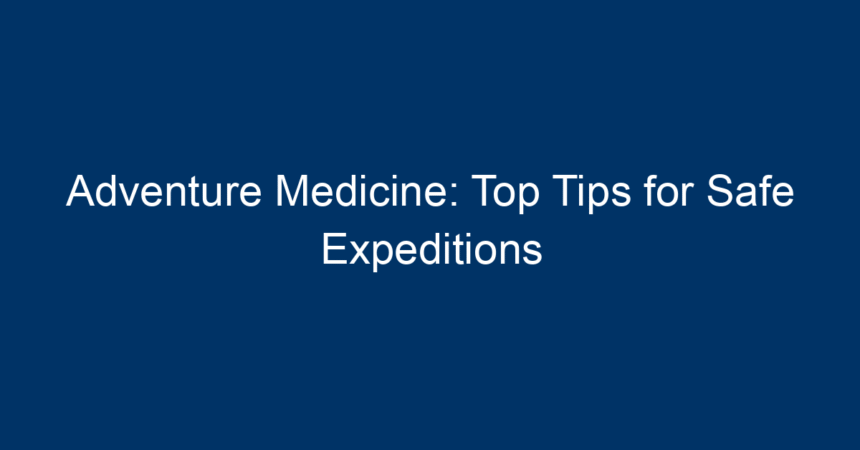Introduction
The thrill of exploration draws many into the great outdoors, seeking experiences that push the boundaries of their physical and mental limits. However, with adventure comes risk. That’s where adventure medicine plays a crucial role. It encompasses the knowledge, skills, and practices needed to ensure safety during rugged expeditions. Whether you’re hiking the Appalachian Trail or climbing Mount Kilimanjaro, understanding adventure medicine can be the difference between a memorable trip and a dangerous situation. In this article, we’ll explore essential tips and insights to keep you safe on your next expedition.
What is Adventure Medicine?
Adventure medicine is a specialized field focused on preparing for, preventing, and managing medical emergencies in remote or wilderness settings. This branch of medicine combines traditional medical practices with specific strategies for dealing with common outdoor injuries and illnesses. Adventure medicine practitioners train in first aid, wilderness survival, and emergency protocols to ensure that adventurers can safely navigate challenging terrains while being prepared for unforeseen incidents.
The Importance of Preparation
Before you embark on any adventure, preparation is key. This isn’t just about packing the right gear; it also involves mental and physical readiness.
Research Your Destination
Familiarize yourself with the specific risks associated with your destination. Whether you’re venturing into the Amazon rainforest or the Rockies, every environment has unique hazards. Look for information on local wildlife, weather patterns, and geographical features that may pose risks.
Assess Your Fitness Level
Understand your physical limits. If you’re not accustomed to long hikes or high altitudes, gradually build your endurance. Physical fitness not only enhances your experience but also prepares your body for unexpected stressors.
Essential Gear for Medical Emergencies
A well-stocked first-aid kit is essential for any adventure. Here’s what to include to ensure you’re prepared for common injuries during your expedition:
1. First-Aid Kit Fundamentals
Your first-aid kit should be customized based on the nature of your expedition. At a minimum, consider including:
- Bandages of Various Sizes: For cuts and scrapes.
- Antiseptic Wipes and Creams: To prevent infections.
- Tweezers: For removing splinters and ticks.
- Pain Relievers: Including ibuprofen or acetaminophen.
- Elastic Bandage: To wrap sprains.
- Emergency Blanket: Lightweight and compact.
2. Advanced Supplies
If you’re venturing into particularly remote or dangerous areas, consider additional supplies:
- SAM Splint: For immobilizing fractures.
- Tourniquet: To stop severe bleeding.
- Oral Rehydration Salts (ORS): For dehydration.
- Hydrocortisone Cream: To alleviate severe allergic reactions.
Understanding Common Injuries and Illnesses
The wilderness can present a variety of medical challenges. Understanding how to respond is critical.
1. Cuts and Scrapes
In the outdoors, cuts and scrapes are common. Clean the wound with antiseptic and cover it with a bandage. If the cuts are deep or bleeding does not stop, seek immediate help.
2. Sprains and Strains
Overextension can lead to sprained ligaments or strained muscles. Rest the injured area, apply ice, and elevate it. Use an elastic bandage for support and limit movement as needed.
3. Dehydration and Heat Illness
Dehydration can occur quickly, especially in hot or physically demanding conditions. Always carry enough water and drink regularly. Watch for signs of heat exhaustion—dizziness, excessive sweating, and rapid heartbeat. If you detect these symptoms, rest in a cool place and hydrate.
4. Hypothermia
Conversely, cold weather can lead to hypothermia. Be aware of symptoms such as shivering, confusion, and a slower heartbeat. If you or a teammate shows these symptoms, act immediately by moving to a warmer location and using blankets or dry clothing to warm the affected person.
Navigating Emergency Situations
Despite all precautions, emergencies can happen. Knowing how to react can save lives.
1. Have an Emergency Plan
Before you head out, establish a plan that includes emergency contacts and a communication strategy. Identify the closest medical facility and familiarize yourself with any emergency services available in the area.
2. Use Technology Wisely
While enjoying the great outdoors, don’t forget the benefits of technology. Carry a GPS device or smartphone with offline maps, and consider a satellite phone or personal locator beacon for emergencies. Ensure your devices are fully charged before your expedition.
Training in Adventure Medicine
Investing time in training can significantly enhance your preparedness. Consider the following options:
1. Wilderness First Aid Courses
Enroll in a wilderness first aid (WFA) course to learn essential skills in managing outdoor injuries. These courses often cover key topics like CPR, wound management, and environmental emergencies.
2. Advanced Wilderness Life Support
For those taking a more serious approach to adventure medicine, advanced courses offer in-depth knowledge of patient assessment and treatment in remote locations. You’ll learn how to handle various medical emergencies while lacking access to immediate medical support.
Building a Supportive Community
Engaging with others who share your passion can enhance your skills and safety.
Join Outdoor Forums and Groups
Participate in local outdoor clubs or online communities. Exchanging experiences and advice can provide insights that make your expeditions safer and more enjoyable.
Buddy System
Always venture into the wild with a partner. The buddy system allows you to watch each other’s backs, provide support in case of emergencies, and share valuable experiences.
Conclusion: Embrace Safe Adventures
Adventure medicine is essential for anyone who enjoys spending time outdoors. By preparing adequately, understanding common injuries, packing the right gear, and investing in education and training, you can significantly enhance your safety. Embrace the thrill of exploration but do so with a commitment to safety and the well-being of yourself and your companions.
Actionable Insights
- Research Your Destination: Know the risks and terrain.
- Prepare Your Gear: Stock a comprehensive first-aid kit.
- Take a Course: Consider enrolling in wilderness first aid training.
- Communicate: Establish an emergency plan and share it with your group.
- Stay Hydrated and Rested: Fuel your body for the challenges ahead.
Adventure awaits, and with the right preparation, you can enjoy every moment safely and confidently. Happy adventuring!




